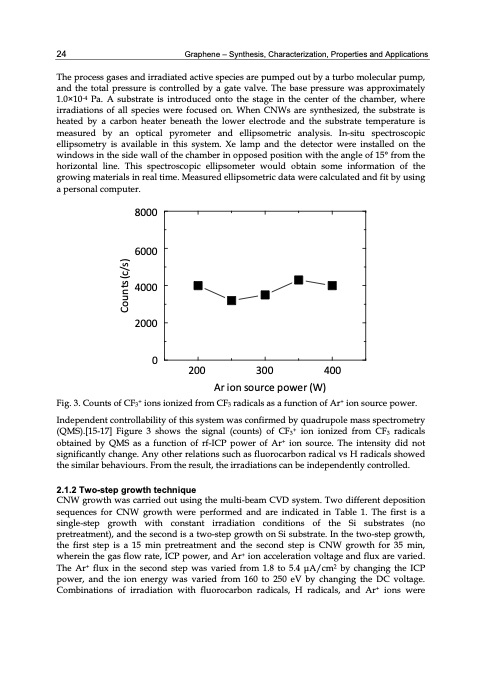PDF Publication Title:
Text from PDF Page: 034
24 Graphene – Synthesis, Characterization, Properties and Applications The process gases and irradiated active species are pumped out by a turbo molecular pump, and the total pressure is controlled by a gate valve. The base pressure was approximately 1.0×10-4 Pa. A substrate is introduced onto the stage in the center of the chamber, where irradiations of all species were focused on. When CNWs are synthesized, the substrate is heated by a carbon heater beneath the lower electrode and the substrate temperature is measured by an optical pyrometer and ellipsometric analysis. In-situ spectroscopic ellipsometry is available in this system. Xe lamp and the detector were installed on the windows in the side wall of the chamber in opposed position with the angle of 15° from the horizontal line. This spectroscopic ellipsometer would obtain some information of the growing materials in real time. Measured ellipsometric data were calculated and fit by using a personal computer. 8000 6000 4000 2000 0 200 300 400 Ar ion source power (W) Fig. 3. Counts of CF3+ ions ionized from CF3 radicals as a function of Ar+ ion source power. Independent controllability of this system was confirmed by quadrupole mass spectrometry (QMS).[15-17] Figure 3 shows the signal (counts) of CF3+ ion ionized from CF3 radicals obtained by QMS as a function of rf-ICP power of Ar+ ion source. The intensity did not significantly change. Any other relations such as fluorocarbon radical vs H radicals showed the similar behaviours. From the result, the irradiations can be independently controlled. 2.1.2 Two-step growth technique CNW growth was carried out using the multi-beam CVD system. Two different deposition sequences for CNW growth were performed and are indicated in Table 1. The first is a single-step growth with constant irradiation conditions of the Si substrates (no pretreatment), and the second is a two-step growth on Si substrate. In the two-step growth, the first step is a 15 min pretreatment and the second step is CNW growth for 35 min, wherein the gas flow rate, ICP power, and Ar+ ion acceleration voltage and flux are varied. The Ar+ flux in the second step was varied from 1.8 to 5.4 μA/cm2 by changing the ICP power, and the ion energy was varied from 160 to 250 eV by changing the DC voltage. Combinations of irradiation with fluorocarbon radicals, H radicals, and Ar+ ions were Counts (c/s)PDF Image | GRAPHENE SYNTHESIS CHARACTERIZATION PROPERTIES

PDF Search Title:
GRAPHENE SYNTHESIS CHARACTERIZATION PROPERTIESOriginal File Name Searched:
Graphene-Synthesis.pdfDIY PDF Search: Google It | Yahoo | Bing
Salgenx Redox Flow Battery Technology: Power up your energy storage game with Salgenx Salt Water Battery. With its advanced technology, the flow battery provides reliable, scalable, and sustainable energy storage for utility-scale projects. Upgrade to a Salgenx flow battery today and take control of your energy future.
CONTACT TEL: 608-238-6001 Email: greg@infinityturbine.com (Standard Web Page)